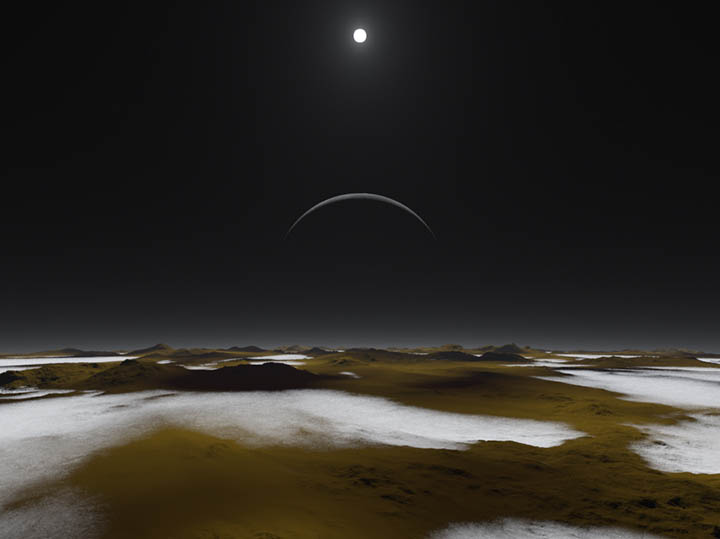Sunlight on Pluto is only a thousandth as strong as it is here on Earth. With careful timing, you can experience what it'd be like to stand on Pluto at noon.
Right now Pluto is 31.94 astronomical units from the Sun. This means that the summery sunlight here in Boston is about 1,000 times more intense (31.94 × 31.94) than it is on Pluto. And while 1⁄1,000 of a Sun might seem very dim, it really isn't. Consider: instead of the Sun's dazzling apparent magnitude of –26.7, as we see it, Plutonians would still see our star as magnitude –19.2. That's more than 400 times brighter than the full Moon.

NASA / Southwest Research Inst. / Alex Parker
For the scientists and engineers managing the New Horizons spacecraft, now less than a month from its history-making flyby of Pluto, accounting for this reduced lighting is just a matter of taking somewhat longer exposures. (It's not quite that simple: the lighting will vary across the globe, and there'll be differences for surfaces that are intrinsically bright or dark.) Still, when all this gets factored in, out pops a set of exposure times that should prove reliable.
For us humans, however, it's more complicated to imagine what we'd experience standing on Pluto. For example, the atmosphere is so tenuous that it would scatter very little light around you. Recall the stark shadows that Apollo astronauts experienced while on the Moon. Yet sunlit portions of the lunar landscape still looked very bright to them.
While it's difficult to imagine what 400 full Moons in the sky, we can get a sense of what midday on Pluto might be like using twilight. It turns out that the sky's total brightness is a good match for "Pluto time" when the Sun is about 1½° below the horizon. This occurs, depending on your latitude, about 8 to 10 minutes before sunrise or after sunset. Of course, it's hardly "dark" at those times! If you were to stand outside then, you'd have no trouble finding your way along a path or reading the July issue of Sky & Telescope (which features Emily Lakdawalla's preview of the New Horizons flyby).
So try experiencing "Pluto time" for yourself. You don't even need to do the calculation — the wizards at NASA have taken care of that for you with a handy online app. My next opportunity is 8:28 p.m. tonight — when's yours?
 Want more background about Pluto and New Horizons' upcoming flyby? Check out the half-hour-long presentation I gave at the NorthEast Astronomy Forum (NEAF) in April.
Want more background about Pluto and New Horizons' upcoming flyby? Check out the half-hour-long presentation I gave at the NorthEast Astronomy Forum (NEAF) in April.
 4
4









Comments
Frank-ReedNavigation.com
June 18, 2015 at 1:06 pm
Another way to imagine the small Sun at Pluto's distance is to consider what the Sun is like when it is 99.9% eclipsed. That thin sliver, broken by mountains and valleys, that's left exposed when the Sun is at 99.9% eclipse has exactly the same total brightness and brightness per unit area as the Sun at Pluto (the brightness per unit area, really unit solid angle, does not change with distance). At this level of eclipse, the landscape around an eclipse-observer on Earth is still quite bright, similar to a few minutes after sunset, just as the 'Pluto Time' web site notes. Still another way to picture the Sun at Pluto's distance is to punch a 1 millimeter diameter hole in a piece of aluminum foil. Stick it on a window, maybe in the mid-afternoon, so that the Sun is behind the aluminum foil. Position yourself at a distance of 3.4 meters from that little hole. Then move around until sunlight passes through that 1mm hole. It is dazzling bright. That is exactly how the Sun looks from Pluto. DO NOT STARE AT IT!! Peek at it for a moment or two, and then look away. The real Plutonian Sun and this mock Plutonian Sun suffer from the same problem that afflicts the almost fully-eclipsed Sun: its light can still damage the retina but it does not readily induce our instinct to avert our eyes.
Of course we already know what the lighting is like on Pluto. We have been "here" before... Way back in 1989, Voyager 2 imaged Neptune and its various moons and that was using the much less sophisticated cameras that were launched on that spacecraft in 1977. Neptune is at nearly the same distance from the Sun as Pluto, and Neptune's large moon Triton (larger than Pluto) is believed to be similar to Pluto, apart from the fact that the surface of Triton was apparently melted and re-worked by whatever cataclysm brought it into orbit around Neptune, perhaps half a billion years ago. Pluto and Triton are near-identical twins, separated at birth... at the birth of the Solar System, that is...
You must be logged in to post a comment.
June 19, 2015 at 7:57 am
As a photographer I'm familiar with the concept of the "Sunny 16" rule. What that means is you take the ISO sensitivity that you are using (say ISO 100) and you make a shutter speed with it, i.e. 1/100.
The exposure in bright cloudless daylight with ISO 100 is 1/100 @ f16. ALWAYS.
Since photographers deal in stops, not percentages, I'd like to know how many stops are lost from Earth's "sunny 16" rule when a photograph is taken on Pluto. On Pluto is the "sunny 16" rule "sunny 2.8"? As far as that goes I'd be interested in knowing what the "sunny 16" rule is on every planet.
You must be logged in to post a comment.
Frank-ReedNavigation.com
June 19, 2015 at 3:24 pm
David G:
A "stop" in photography is a factor two. Since two raised to the tenth power is 1024, the surface illumination from the Sun on Pluto is just about ten stops different from here on Earth.
For the other planets, all you need to do is take their distance from the Sun in AUs (multiples of Earth's distance from the Sun) so Jupiter, e.g., that's 5.2, and square that number. Then find the nearest corresponding power of two. For Jupiter, the square of 5.2 is a bit more than 27. The nearest power of 2 is 32, which is two to the fifth, so the number of "stops" changes by 5 going from normal solar illumination on Earth to the same at Jupiter's distance from the Sun.
Or use this simple rule: for every factor of two increase in distance from the Sun, add two stops (if you're 8 times further from the Sun than the Earth, that's three factors of two, so six stops). For something more extreme, if you were 250 times further from the Sun than the Earth, that's eight factors of two in distance (near enough) so that implies 16 "stops" in photographic terms.
If you want a more exact number, take that distance in AUs, get its "base-10 logarithm" (any scientific calculator will give this) and then multiple by 6.64. For example, if distance is 31, like for Pluto, then that's a change of 9.9 stops.
You must be logged in to post a comment.
June 19, 2015 at 6:54 pm
So the sunny 16 rule on Pluto would be 1/8 @ f2 with ISO 100. That's opening up the exposure by six stops on the aperture side and four stops on the shutter speed side.
You must be logged in to post a comment.
You must be logged in to post a comment.